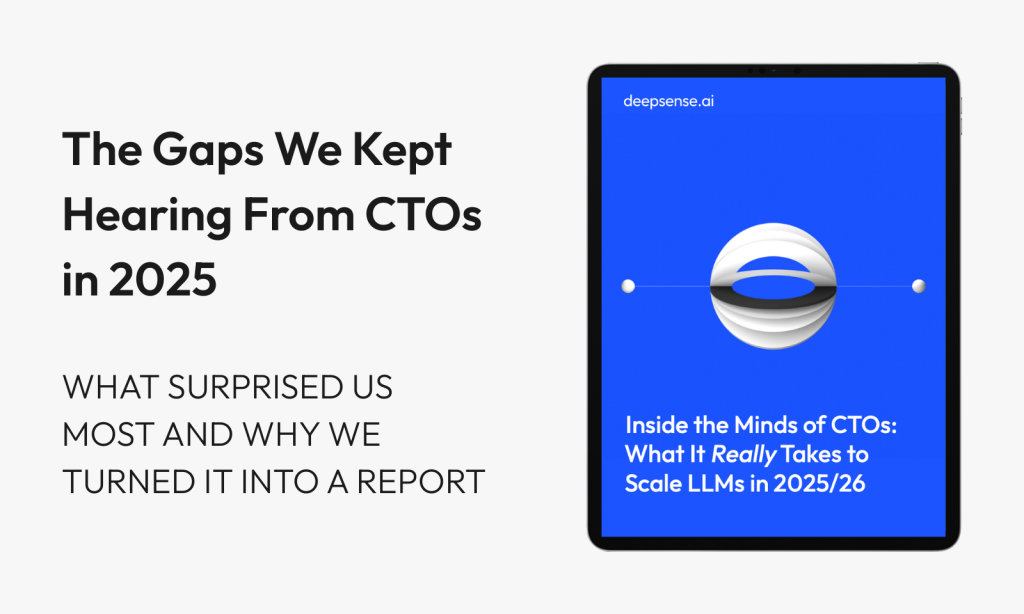
Table of contents
Nearly 75% of corporate AI initiatives fail to deliver on their promise, and up to 85% never reach full production. That’s often twice the failure rate of traditional IT projects. Most failures trace back to misalignment between business objectives, data readiness, and execution.
For product and delivery managers, this means: if you don’t crystallize the business-KPI-product pipeline up front, you’re building a feature, not validated value.
I’ve been a Delivery Manager for 17 years, including 9 in the AI space, and these are my reflections on the industry, and how we’ve refined our process to deliver ROI quickly and consistently.
TL;DR
- Up to 85% of AI initiatives fail, with most never reaching production. That’s 2× worse than traditional IT projects.
- The primary cause? Misalignment between business goals, data readiness, and technical execution.
- For delivery managers, success hinges on crystallizing the business–KPI–product pipeline before any code is written.
- AI projects don’t fail because of weak models, but because of fragmented collaboration, unclear ROI, and lack of operational clarity.
What You’ll Learn From This Article
- A practical breakdown of business vs. operational goals, and how to align them through a shared delivery plan.
- A 3-step framework (Business Goals → Data Readiness → Product Roadmap) for structuring AI initiatives that succeed.
- How cross-functional collaboration directly boosts success odds, when done right.
- The key traits of a strong advisor-developer, and why technical expertise alone is not enough.
- What “value delivered before a line of code is written” really looks like.
The Intersection of Business and Technology – Where to Find It?
To locate this often hard‑to‑define space, explore the area between a project’s primary (business) objective and its operational goal.
- The primary objective is the intended business outcome, for example, reducing the cost of handling customer inquiries.
- The operational goal drills down to the product level, the means of achieving that outcome, such as an AI-powered inquiry automation system.
- Beneath that lies the work breakdown structure (WBS): the concrete tasks needed to build the product.
Achieving business outcomes requires designing the right product and planning the actions to build it. That’s where the intersection appears.
Defining Roles
- Business stakeholders should define the primary (business) objective, as they understand the organization’s strategic direction and customer context.
- Technical stakeholders should define the operational goal, articulate the product, and outline the required actions—they know which tools and approaches can efficiently fulfill business goals.
The closer the alignment between tools (products, systems, activities) and expected business outcomes, the higher the chance of delivering results that satisfy organizational needs.
At least two factors critically influence this alignment:
- The quality of collaboration between business and technical stakeholders.
- The competencies of those stakeholders.
A Structured Process for Product & Delivery Managers
Turning an AI initiative into a successful product doesn’t start with models—it starts with clarity, alignment, and disciplined delivery design. Before any code is written, delivery managers must lead a process that connects business intent to technical feasibility. The following three steps help anchor AI initiatives in real business value, reduce risk, and create the conditions for scalable execution.
Step 1 – Define Business Outcomes & Metrics
- Target ROI within 12 months; pilot validation can happen within 8 months.
- Proof point: “Pilot reduced average handling time by 85% and delivered ROI within 8 months.”
Step 2 – Technical Scope & Data Readiness
- Decide whether AI is necessary based on KPI alignment, not technology for its own sake.
- Validate data quality early: poor hygiene and governance derail up to 85% of projects.
Step 3 – Product Blueprint & Agile Roadmap
- Convert outcomes into MVP-aligned epics and sprint-ready backlog items.
- Prioritize by business value vs. technical risk; assign each feature to a measurable KPI.
Collaboration Quality at the Business‑Technology Intersection
In previous years, business leaders tended to place near‑magical expectations on cloud computing, believing, “just move it to the cloud and business barriers will vanish.” Reality soon intervened: cloud can help, but it also introduces growing (and potentially unbounded) costs.
Today, the magic is centered around AI. Compared to cloud hype, AI may indeed deliver—but the key question for organizations becomes: “Can it reliably deliver the business goals we’ve defined?”
At deepsense.ai, our decade-plus experience spans eras, from predictive analytics and CNNs, through LSTMs and classifiers, to the LLM revolution in the past 8 years. We bring both historical perspective and modern AI experience into defining business outcomes and aligning solutions pragmatically. We strongly believe in the potential of AI, but we do not support its overhyped versions.
How We Structure Collaboration in AI Projects
If this is not an AI Guidance project, starting from scratch to find the use case, we typically engage after the business goal is defined. Our first task is to delve deeply into that goal, often the hardest step. When client groups merge teams with distinct priorities (e.g. ten people from two departments), our role is to mediate conflicting agendas, merge them into a clear single business objective.
Business ideas come in all shapes:
- simulating chemical reactions,
- building spatial‑phonetic maps,
- automating administrative assistants,
- or organizing document piles.
Early on, we listen, question, and draft a high‑level product vision aimed at realizing each client’s idea effectively.
We advise transparently: not every problem needs machine learning. If business objectives can be solved via traditional logic or automation, we say so clearly. In most cases though, ML is part of the solution.
Once a high‑level product concept is accepted, we progress to roadmapping and building a work breakdown structure. At that point:
- The business goal is clarified.
- The operational goal is set.
- Both high‑level and low‑level product visions exist.
- A task breakdown and resource estimate are in place.
This satisfies two of the top three success drivers in project management research: defined goals and planning with progress tracking.
Framework: What We Do at the Intersection
| Phase | Focus | Key Collaboration Output |
| Discovery | Clarify business goals & align stakeholder views | Shared objective agreement |
| Feasibility | Assess solution approach & data readiness | Technical‑business consensus |
| Blueprinting | Draft product concept and roadmap | Agreed MVP, epics, budget |
| Planning | Build WBS and resource plan | Delivery plan linked to ROI |
| Execution | Maintain alignment through incremental delivery | Feedback loops & stakeholder reviews |
Up to this point, no code has been written, but significant value is already realized:
- Endpoint alignment of goal and solution.
- Blueprint ready for delivery.
- Clear roadmap, team structure, and budgets.
These are foundational success factors: early goal clarity and structured progress appear repeatedly across 30+ years of research in project management.
Stakeholder Competence – What Makes a Good Advisor‑Developer for AI Projects?
With client consulting defined, it’s critical to ask: Who is best suited to guide clients in building AI-based products? At deepsense.ai, this advisory role is entrusted to our most seasoned engineers, our technical leaders. Below is what makes them effective.
1. Experience & Domain Breadth
- Effective technical leaders are engineers with years of practical experience across multiple industries and project types, enabling them to deeply understand clients’ evolving needs and design creative, relevant solutions.
- The competence areas essential for AI practitioners now encompass technical, business, and interpersonal skills.
2. Technical Proficiency & AI Literacy
- Beyond broad background, technical leaders possess specialist expertise, such as working with large‑language models, retrieval‑augmented generation, edge AI, or data science frameworks.
- They combine data fluency with strategic understanding to interpret model outcomes, assess data readiness, and align technical choices with business impact.
3. Communication & Cross-Functional Coordination
- Leaders must bridge gaps between technical and non‑technical domains. Developers often need to translate complex data concepts to stakeholders, construct shared mental models, and manage trust and expectations.
- Strong communicators adapt their message to the audience, from technical teams to executives to legal/compliance teams.
4. Strategic & Ethical Leadership
- A truly effective advisor‑developer isn’t just technical, they combine strategic judgment with ethical responsibility. Leadership competencies now include ecosystem building, customer obsessiveness, execution focus, and sustainability advocacy.
- Further, high-performance leadership, characterized by vision, empathy, trust, proactive risk management, inclusive communication, and talent development, correlates directly with AI success.
Staffing your teams with technical leaders who combine AI fluency, cross-functional coordination, strategic thinking, and ethical awareness increases the odds of scaling AI successfully. They act as the bridge between technology potential and business result, without unnecessary complexity or risk.
In Summary
Most AI projects fail not due to model performance, but because of broken alignment between business expectations and delivery execution. Data issues, ambiguous objectives, and siloed teams compound the risk.
This article shows how to fix that:
- Map business objectives to operational goals and concrete tasks early.
- Validate data readiness before scoping a solution.
- Assign clear responsibilities between business and technical stakeholders.
- Build and sustain cross-functional teams with shared goals, governance, and delivery rhythm.
- Choose technical leaders with the right mix of experience, communication, strategic thinking, and ethical awareness—not just coding skills.
With these principles in place, value starts being delivered long before the model is deployed, and continues to scale sustainably once it is.
Table of contents






